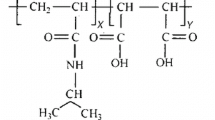Abstract
The paper describes a new device that allows us to study the effect of ultraviolet irradiation on the electrorheological characteristics of new photosensitive materials based on colloidal polyimide systems containing SO3H (PI-I) and SO3Na (PI-II) groups. The samples were analyzed using rotational viscometry methods, and a significant effect of irradiation of the systems on the flow velocity and hence the viscosity of the medium and the electrorheological response was shown. At the same time, the dimensional and microrheological properties of colloidal polyimide systems in polar and nonpolar media under simultaneous ultraviolet irradiation and exposure to an electric field were monitored using IR spectroscopy and dynamic light scattering methods. The mobility and zeta potential of polyimide molecules were determined using a sensitive method of phase analysis of light scattering. It is shown that in almost all cases, irradiation of colloidal systems of polyimides led to the uncontrolled formation of larger particles, which decreased during the thermal reaction almost to the initial size, which indicates the stability of the studied systems to external influences (irradiation and electric current).
Graphical abstract










Similar content being viewed by others
Data Availability Statement
This manuscript has associated data in a data repository. [Authors’ comment: All data included in this manuscript are available upon request by contacting with the corresponding author.]
References
T.C. Halsey, Electrorheological fluids. Science 258, 761–766 (1992). https://doi.org/10.1126/science.258.5083.761
T. Hao, Electrorheological suspensions. Adv. Colloid Interface Sci. 97, 1–35 (2002). https://doi.org/10.1016/s0001-8686(01)00045-8
S. Peng, Q. Guo, T.C. Hughes, P.G. Hartley, Reversible photorheological lyotropic liquid crystals. Langmuir 30, 866–872 (2013). https://doi.org/10.1021/la4030469
S. Qiao, H. Wang, Temperature-responsive polymers: Synthesis, properties, and biomedical applications. Nano Res. 11, 5400–5423 (2018). https://doi.org/10.1007/s12274-018-2121-x
N. Gavrilova, I. Ivanov, V. Nazarov, Rheological properties of Ce0.5Zr0.5O2 hydrosols. Colloids Surf. A. 604, 125308 (2020). https://doi.org/10.1016/j.colsurfa.2020.125308
M. Schwartz, Encyclopedia of Smart Materials (Wiley, NY, 2002)
M.-Y. Cho, J.-S. Kim, H.J. Choi, S.-B. Choi, G.-W. Kim, Ultraviolet light-responsive photorheological fluids: as a new class of smart fluids. Smart Mater. Struct. 26, 054007 (2017). https://doi.org/10.1088/1361-665x/aa5aae
H.-Y. Lee, K.K. Diehn, K. Sun, T. Chen, S.R. Raghavan, Reversible photorheological fluids based on spiropyran-doped reverse micelles. J. Am. Chem. Soc. 133, 8461–8463 (2011). https://doi.org/10.1021/ja202412z
A.M. Ketner, R. Kumar, T.S. Davies, P.W. Elder, S.R. Raghavan, A simple class of photorheological fluids: surfactant solutions with viscosity tunable by light. J. Am. Chem. Soc. 129, 1553–1559 (2007). https://doi.org/10.1021/ja065053g
C. Gäbert, T. Rosenstingl, D. Linsler, M. Dienwiebel, S. Reinicke, Programming viscosity in silicone oils: reversible tuning of rheological properties in 9-anthracene ester-terminated polydimethylsiloxanes. ACS Appl. Polym. Mater. 2, 5460–5468 (2020). https://doi.org/10.1021/acsapm.0c00794
H.D. Roth, The beginnings of organic photochemistry. Angew. Chem. Int. Ed. Engl. 28, 1193–1207 (1989). https://doi.org/10.1002/anie.198911931
J. Jin, X. Wang, S. Hu, J. Geng, D. Jing, Unusual photorheological properties of TiO2 nanoparticle suspensions under UV light irradiation. J. Phys. D Appl. Phys. 52, 275301 (2019). https://doi.org/10.1088/1361-6463/ab1a91
Y. Komoda, N. Sakai, T.N. Rao, D.A. Tryk, A. Fujishima, Photoelectrorheological phenomena involving TiO2 particle suspensions. Langmuir 14, 1081–1091 (1998). https://doi.org/10.1021/la9706633
Y. Komoda, T.N. Rao, A. Fujishima, Photoelectrorheology of TiO2 nanoparticle suspensions. Langmuir 13, 1371–1373 (1997). https://doi.org/10.1021/la961059f
B.M. Rumyantsev, V.I. Berendyaev, N.A. Vasilenko, S.V. Malenko, B.V. Kotov, Photogeneration of charge carriers in layers of soluble photoconducting polyimides and their sensitization by dyes. Polym. Sci Ser. A 39, 506–512 (1997)
E. Kelbysheva, A. Danilin, V. Gorodov, I. Kuchkina, N. Semenov, Sulfonic acid polyimides and their salts—properties of their particals in solution and suspension. Nanosci. Technol. Int. J. 14, 29–42 (2023). https://doi.org/10.1615/NanoSciTechnolIntJ.2022045709
Y. Ding, H. Hou, Y. Zhao, Z. Zhu, H. Fong, Electrospun polyimide nanofibers and their applications. Prog. Polym. Sci. 61, 67–103 (2016). https://doi.org/10.1016/j.progpolymsci.2016.06.006
G. Schramm, A Practical Approach to Rheology and Rheometry (Karlsruhe, Federal Republic of Germany, Gebrueder Haake, 1994), pp.57–59
A. Sze, D. Erickson, L. Ren, D. Li, Zeta-potential measurement using the Smoluchowski equation and the slope of the current–time relationship in electroosmotic flow. J. Colloid Interface Sci. 261, 402–410 (2003). https://doi.org/10.1016/S0021-9797(03)00142-5
B.J. Kirby, E.F. Hasselbrink, Zeta potential of microfluidic substrates: 1. Theory, experimental techniques, and effects on separations. Electrophoresis 25, 187–202 (2004). https://doi.org/10.1002/elps.200305754
B.J. Kirby, E.F. Hasselbrink, Zeta potential of microfluidic substrates: 2. Data for polymers. Electrophoresis 25, 203–213 (2004). https://doi.org/10.1002/elps.200305755
C.N. Lunardi, A.J. Gomes, F.S. Rocha, J. De Tommaso, G.S. Patience, Experimental methods in chemical engineering: zeta potential. Can. J. Chem. Eng. (2021). https://doi.org/10.1002/cjce.23914
F. Ke, N. Song, D. Liang, Xu. Hongyao, A method to break charge transfer complex of polyimide: a study on solution behavior. J. Appl. Polym. Sci. 127, 797–803 (2013). https://doi.org/10.1002/app.37782
M. Horie, H. Kato, K. Fujita, S. Endoh, H. Iwahashi, In vitro evaluation of cellular response induced by manufactured nanoparticles. Chem. Res. Toxicol. 25, 605–619 (2011). https://doi.org/10.1021/tx200470e
M. Beck-Broichsitter, O.M. Merkel, T. Kissel, Controlled pulmonary drug and gene delivery using polymeric nano-carriers. J. Control. Release 161, 214–224 (2012). https://doi.org/10.1016/j.jconrel.2011.12.004
V. Gopalakrishnan, C.F. Zukoski, Delayed flow in thermo-reversible colloidal gels. J. Rheol 51, 623–644 (2007). https://doi.org/10.1122/1.2736413
Acknowledgements
Spectral studies by infrared spectroscopy were performed using the scientific equipment of the Center for molecule composition studies of INEOS RAS.
Funding
The work was financially supported by the Russian Science Foundation (Project 22-19-00678).
Author information
Authors and Affiliations
Corresponding author
Ethics declarations
Conflict of interest
The authors declare that they have no known competing financial interests or personal relationships that could have appeared to influence the work reported in this paper.
Rights and permissions
Springer Nature or its licensor (e.g. a society or other partner) holds exclusive rights to this article under a publishing agreement with the author(s) or other rightsholder(s); author self-archiving of the accepted manuscript version of this article is solely governed by the terms of such publishing agreement and applicable law.
About this article
Cite this article
Kelbysheva, E.S., Danilin, A.N., Ezernitskaya, M.G. et al. Photoelectrorheological properties of polyimides with sulfo-acid and sodium salt sulfo-acid groups: a comparative study. Eur. Phys. J. Plus 138, 747 (2023). https://doi.org/10.1140/epjp/s13360-023-04383-6
Received:
Accepted:
Published:
DOI: https://doi.org/10.1140/epjp/s13360-023-04383-6




